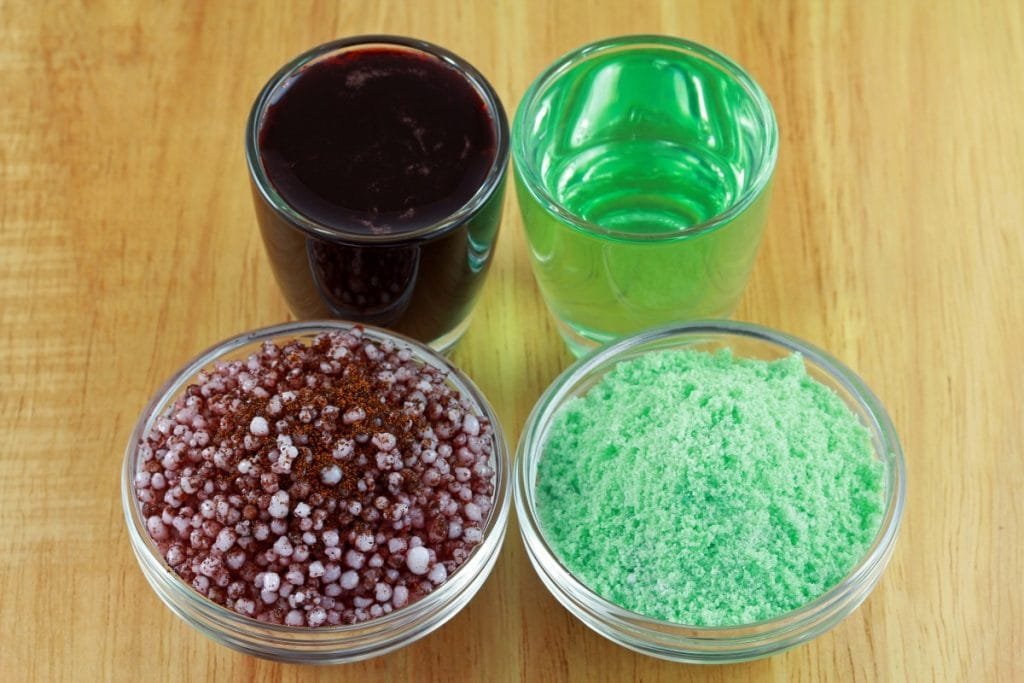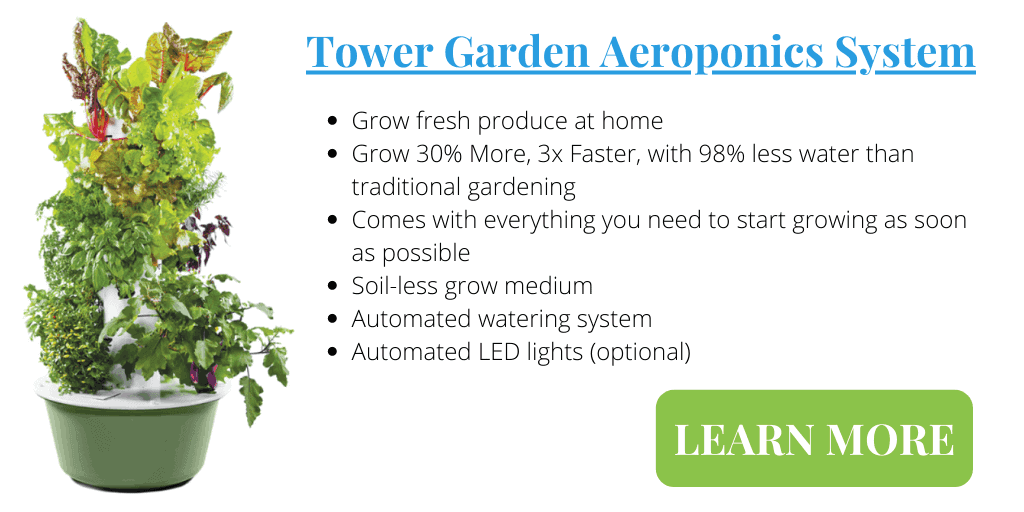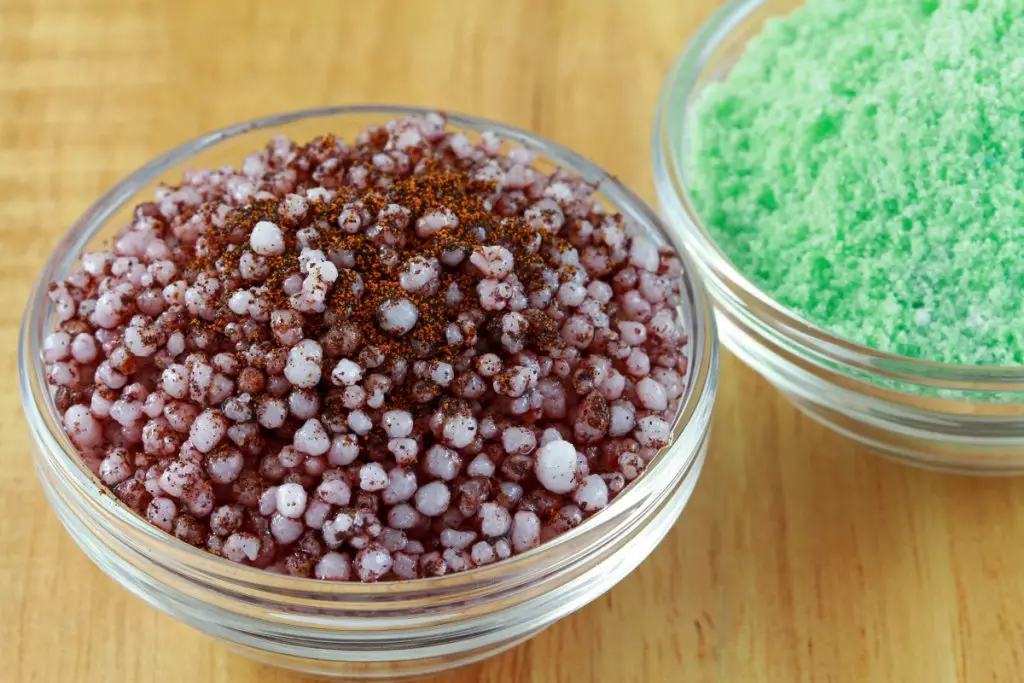Growing food plants and other herbs hydroponically is an undertaking gaining popularity both as a means of growing food or as a hobby. Plants in hydroponics systems need more than just water to survive and thrive. Hydroponic nutrients have been formulated to give your plants the food they need. The nutrients come in concentrated liquid or powder form. Are powder nutrients the best choice for you?
Powder nutrients offer benefits over liquid nutrients, making them a good choice for serious growers. They offer more customized nutrient levels for different plant species, better shelf life for bulk buying, and better value for money. Liquid nutrients are good for starting hydroponics.
Plants need different vitamins and minerals in their different growth stages, whether in the ground or in a hydroponic system. Because plants in hydroponics are in a closed system, we need to feed them the right nutrients at the right time to maximize their growth and production. The two main types of nutrients are liquid and powder. We will investigate the differences and benefits of these hydroponic nutrient types for you to make an informed choice regarding the right type for your needs.

What Are The Benefits Of Powdered Hydroponic Nutrients?
Liquid hydroponic nutrients have dominated the hydroponic nutrient industry for many years, but many growers are seeing the benefits of powder nutrients and are choosing this option instead.
Liquid nutrients come in a concentrated liquid form that is pre-mixed in a specific ratio for different plant growth stages. They are easy to mix and dilute into your hydroponic solution and have shown great results.
So why are powder nutrients gaining popularity over a proven recipe that provides convenience and ease of use? Powder nutrients offer benefits that present advantages over liquid nutrients in some circumstances.
We will examine some of these advantages, which may give you a better fit for what you want to achieve with your hydroponics system.
Our Favorite Powder Hydroponic Nutrients
- MasterBlend 4-18-38 Master Kit (3 Separate Components in correct amounts)
- Contains MasterBlend 4-18-38, Calcium Nitrate 15.5-0-0, and Epsom Salt (Magnesium Sulfate)
- Used by professionals worldwide for optimum plant growth
Mix Your Own Nutrient Ratios
Even though liquid nutrients are easy to use, they come in pre-mixed ratios, which are compiled to be generic for most plants and growing systems. They can be considered broad-spectrum nutrients designed to cover a wide range of plants.
Liquid nutrients are created from minerals and vitamins in powdered form but are pre-mixed into a concentrated liquid for convenience.
Obtaining the base nutrients in powdered form that liquid nutrient manufacturers use to make their nutrients is not a viable option. Many of the component products have to be purchased in bulk to be cost-effective, and some products are restricted and require special permits to use. Mixing many of the compounds safely also requires specialist knowledge and care to maintain the correct pH of the mix at the same time.
The best option is to procure powdered nutrients from a supplier of powdered nutrients who has done most of the hard formulation work for you. You can then use the powder nutrients to tweak your feed solution ratios and customize quantities for different plants, growth stages, and growing conditions.
When using powder nutrients to create your own nutrient mix, you have more control over the ratios used for feeding your plants, giving you more flexibility to create your own custom nutrient mix. Mixing your own custom ratios allows you to fine-tune the recipe to provide mixes that are dedicated to specific plant species to maximize their growth and production.
Climate conditions can affect how plants absorb nutrients, which means that nutrients mixed for a certain geographic location may not work optimally in your location. This is especially true if your hydroponics system is located outdoors where the plants and the system are exposed to the elements.
Mixing your own nutrient ratios does require more knowledge about the nutrients your plants need and how to mix the ratios, but this additional knowledge will make you a better hydroponic grower.
Achieving the right mix and watching your plants thrive and produce high-yield crops is extremely satisfying when you have put in the groundwork to improve your knowledge and skill.
This may sound like a lot more work than liquid nutrients, but once you get the basics right and keep notes of your mixes, it is actually not much more difficult, only taking a little more time.

Easier Nutrient Storage
Powder nutrients are easier to store, taking less space than bottles of liquid concentrate. The powder is compact and highly concentrated, which allows more nutrients to be stored in powder form than liquid form.
Many liquid nutrient concentrates need to be protected from sunlight and have a limited shelf life. In certain mixes, the concentrate can flocculate over time, where some of the nutrients come out of suspension in the solution and form a sludge at the bottom of the bottle.
While shaking the bottle can dissolve some of this sludge, it not always dissolves completely, which will affect the nutrient ratio in the liquid.
Powder nutrients can be kept in their powder state until needed. The only factor that affects powder nutrients is excessive humidity which can cause the powder to clump or become hard. This is easily solved by storing your powder nutrients in an airtight container once the packaging has been opened.
This gives the powder form of hydroponic nutrients a longer shelf-life, which gives you the option to buy larger quantities and store them for a long time.

Easier Nutrient Transportation
Hydroponic growing is a growing technique that is catching on and becoming popular, but it still may be difficult to source nutrients in certain locations. There may not be a supplier close to you, which would require sourcing your nutrients from further afield.
This limitation often means sourcing your hydroponic nutrients online. Transporting powder may be a little heavier, but your get more nutrient concentration for the same weight as with liquid nutrients.
With liquid nutrients, there is the potential of spillage due to caps not fitted correctly or your package stored upside down in transit. These transportation issues are less of a problem with powdered nutrients.
Powder Nutrients Offer Better Value For Money
Liquid nutrients are powder nutrients that have been mixed at high concentration levels in water. even though the nutrient level is concentrated, much of the volume and the weight of the bottle is made up of water.
Water is not the only additive to liquid nutrients; they also include stabilizers to prevent the nutrients from coming out of solution.
The cost of buying liquid nutrients includes the cost for these stabilizers, the cost of mixing the liquid, and a high volume of water.
Powder nutrients, in contrast, do not contain water or stabilizers, so what you are paying for is just the pure nutrients. This makes powder hydroponic nutrients better value for money than liquid nutrients.
Summary Comparison Of Powder And Liquid Hydroponic Nutrients
There is a place for both powder and liquid hydroponic nutrients, and the one you choose to use as your preferred type will depend on what you are growing, your goals for growth, and your location.
To summarize the differences between the two nutrient types, here is a table with the main points for your convenience.
| Powder Nutrients Pros | Powder Nutrients Cons | Liquid Nutrients Pros | Liquid Nutrients Cons |
|---|---|---|---|
| Mix your own ratios | More complex | Convenience of pre-mix | Less flexible |
| Easier to store – longer shelf life | Sensitive to moisture | Easier to use off the shelf | Limited shelf life of about 2-years |
| Easy to transport | Heavier to ship | Bulky to transport | Bottles can leak |
| Best for bulk buying | You can buy in smaller quantities | ||
| Less expensive – Better value for money | More expensive | ||
| Easier to customize for specific crops | Takes more time | Generic broad-spectrum nutrients | Not easy to customize for specific crops |
How To Mix Powder Hydroponic Nutrients
The method that you use to mix powder nutrients will depend on the product that you use. The best advice on this aspect is to follow the manufacturer’s guidelines explicitly.
Liquid nutrients are less concentrated than powder nutrients, so if you accidentally add too much or the hydroponic nutrient, there is less chance of harming your plants with an overdose.
Because powder nutrients are much more concentrated, making a mistake with the measurements can make the nutrients too concentrated in the solution. This can damage the plant’s root system or effectively “burn” the plants, which can cause them to die.
The following are some basic tips for mixing powder nutrients that are applicable to all powder nutrients, irrespective of brand.
- Dissolve the nutrients in water before adding them to your system. You should always dissolve your powder hydroponic nutrients in a little warm water before adding them into your hydroponic system. Some of the powders take some time and stirring to get them to dissolve completely. If you add them to your system in powder form, they could just sink to the bottom of your solution container and not dissolve. This means the nutrients will not be available to your plants.
- Never dissolve powder nutrients in boiling water. Boiling hot water is too hot for this purpose. The heat from the water can denature or damage some of the minerals and vitamins contained in the powder nutrients. If the chemical composition of the nutrients is damaged, it could affect how well the plants can absorb the food and affect their growth.
- Mix the powder nutrients in the correct order. Follow the manufacturer’s instructions to mix the nutrient powder in the correct order. Mixing the nutrients in the wrong order can initiate a volatile chemical reaction within the nutrients which can cause it to bubble over or generate heat in an exothermic reaction. You want to avoid either of these scenarios to use the nutrients safely.
- Add the dissolved nutrients to the reservoir, not the system. Always pour your dissolved powder nutrients into the nutrient reservoir or sump rather than into the system itself. The turbulence in the sump will help to distribute the nutrients evenly throughout the solution, making sure all the plants get equal access to fresh food. The turbulence in the sump will also help to keep the nutrients dissolved.
- Always mix calcium nitrate separately and add it individually to the sump. While it is acceptable to add other dissolved nutrients together before adding them to the nutrient tank, your should always mix your calcium nitrate powder separately and add it to the tank on its own. This is to prevent a chemical reaction between the calcium nitrate and the other nutrients and also because the calcium nitrate is a little more difficult to dissolve.
How Often Should You Add Powder Hydroponic Nutrients?
Once powder nutrients are dissolved and added to your system, you monitor them in the same way as liquid nutrient levels. Two tools that are the hydroponic grower’s best friends are an EC meter and a pH meter.
The manufacturer of your powder nutrients will give you the recommended EC levels you should shoot for in the nutrient solution. The EC reading will be different for each growing stage of your plants or for the season you are in.
The temperature of the water can affect the availability of nutrients to the plants, so there are often different EC readings applicable in cooler and warmer seasons.
Your pH meter will help you to monitor the acidity of the nutrient solution, and you may need to add pH leveling substances to get the pH back in the optimal range. Different plants prefer different pH levels, and an incorrect level will affect the plant’s effective absorption of the nutrients.
Thus, it is possible to have the correct nutrient level but a wrong pH level, which will cause your plants to be malnourished because they cannot take in the nutrients due to the pH level.
You can get some EC meters that are combined with a pH meter all in one unit, but these are usually fairly expensive. My preferred choice is for a separate pH and EC meter. These two pieces of equipment are indispensable in the hydroponic grower’s toolkit!
- Application: Great for all home and laboratory TDS & pH testing applications including...
- PH Meter: Full measurement range of pH 0 - 14, reliable and quick readings
- 3-in-1 TDS Meter: Measurement Range 0-9990ppm, 0-9990µs/cm; Accuracy ± 2%, 0.1- 80.0°C,...
- Monitor 3 parameters in water: Conductivity (TDS) level to ensure plants get a balanced feed,...
- This hydroponics meter has ATC that provides consistent reading regardless of any fluctuations...
- Combine with Bluelab meters and controllers for full indoor garden nutrients monitoring in...
Are Powder Hydroponic Nutrients Better Than Liquid Nutrients?
Powder nutrients are not necessarily better than liquid nutrients, but give you more control over your growing environment. Powder nutrients give you more options whether you grow in an ebb and flow, aeroponics or any other type of hydroponic system.
Most people who start out in hydroponics begin by using liquid nutrients because it is easy and uncomplicated. As you progress in your hydroponic endeavor, you will find that powder nutrients make more sense from a value for money standpoint as well as for finer control over the nutrients offered to different plant types in different conditions.
It may come across sounding like you need to be a part-time chemist or alchemist when dealing with powder nutrients, but this is merely a perception. Managing powder nutrients is not as difficult as it sounds, and once you become familiar with the products, it will not be any more intimidating than liquid nutrients!
Conclusion
Powder hydroponic nutrients are considered to be for hydroponic growers who have got to the level where hydroponics is somewhat more serious than just a hobby! While you can go very far with liquid hydroponic nutrients, at some point, it will be more cost-effective to make the switch when your hydroponic growing becomes more intense.
Powder nutrients offer more flexibility for mixing nutrients for specific crop plants to optimize the growth and ultimately their fruit production.
Liquid nutrients are such a broad spectrum that some of the nutrients in the solution may be wasted because the plants you are growing require less of certain minerals. Powder nutrients give you the option of tweaking your nutrient levels to your growing needs, which also reduces waste.
If you have just started out in hydroponics and have been using liquid nutrients for a while, give the powder nutrients a try. It’s easier than you think, and you may be surprised at the results you get with this option!



